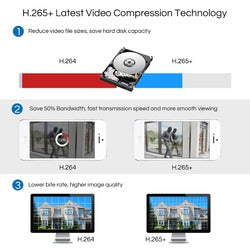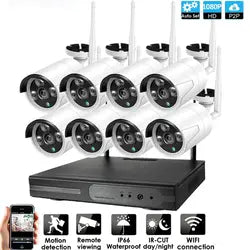
Feb 2023
0 Comments
MackTech Biz
How To Choose The Perfect Video Encoding For Your CCTV Videos
In this blog post, we will look at how to choose the perfect video encoding for your CCTV videos. CCTV video encoding is the process of converting analog video signals from CCTV cameras into a digital format that can be stored on a computer or other digital media.
CCTV video encoding can be done using a variety of different codecs, compression formats, and encoder types. Each codec has its own advantages and disadvantages, so it is important to choose the right codec for your specific needs.
Some of the most popular codecs for CCTV video encoding include MPEG4, H.264, H.265. H.265+, and MPEG. MPEG4 is a lossy compression format that is typically used for streaming video. H.264 is a codec that offers better compression and quality than MPEG4. MJPEG is a lossless compression format that is typically used for storing video. H.265 and H.265+ is newer and more advanced than H.264 in several ways.
The process of choosing the perfect video encoding for your CCTV videos can be complex. However, by following the tips in this blog post, you can ensure that you choose the right codec for your needs.
What Video Encoding Means:
Video encoding is the process of converting analog video signals into a digital format for storage on a computer or other digital media. The digital video codec used for CCTV video encoding is typically MPEG4, H.264, H.265, H.265+. Each codec has its own advantages and disadvantages, and the codec chosen should be chosen based on the user’s needs. MPEG4 is a lossy compression format that is usually used for streaming video. H.264 is a newer codec that offers better compression and quality than MPEG4, while maintaining a smaller file size. MJPEG is a lossless compression format that is generally used for storing video. Each codec has its own features, like support for wide color gamut, frame rate, and resolutions, and different codecs can also have different encoding speeds and quality. When selecting the video encoding for your CCTV system, it’s important to keep in mind the intended use of the video footage. If you’re recording video in low-light conditions, for example, you’ll want to choose a codec with good compression. On the other hand, if you’re recording video in high-resolution or frame rate, you’ll want to choose a codec that can process the extra data associated with the greater resolution or frame rate.
Why the Quality of CCTV Video Matters:
CCTV video quality is an important factor to consider when choosing the perfect video encoding for your CCTV system. Poor quality video can lead to distorted images, pixelation, and other problems that can seriously hinder the ability of your surveillance system to capture and store clear video data. In addition, poor quality video may cause problems with playback, depending on the format in which the video is stored. The quality of the video encoded by your CCTV system is also dependent on the codec used for the encoding. The two most popular codecs for CCTV video encoding are the H.264 and H.265. While both offer good compression and quality, the newer H.265 codec offers better compression and quality with smaller file sizes. H.265 (also called HEVC, or High Efficiency Video Coding) allows for further reduced file size, and therefore reduced required bandwidth, of your live video streams. Unlike H.264 macroblocks, H.265 processes information in what’s called coding tree units (CTUs). Whereas macroblocks can span 4x4 to 16x16 block sizes, CTUs can process as many as 64x64 blocks, giving it the ability to compress information more efficiently. Because H.265 compresses your data so much more efficiently, using it as your video compression tool will drop your bandwidth and storage requirements by roughly 50%.
Then what is H.265+
It is a remarkable encoding technology based on the H. 265/HEVC (High Efficiency Video Coding) standard and is optimized while fully considering the following features of the surveillance video. According to whitepaper released by Hisilicon, the H.265+ can further reduce 50% bitrate than conventional H.265 video compression in typical IP video surveillance scenario. Similar to H.264+, H.265+ is an enhanced video compression technology based on its predecessor H.265.
In a nutshell, H.265+ can save approximate 50% bitrate than H.265, which means it can lower bandwidth and storage consumption further. By using H.265+, IP camera can deliver smooth 1080P (30 frames per second) video stream under as low as 500kbps.

Besides H.265+, other companies also released enhanced H.265 video compression technologies such as H.265X, H.265++. H.265X and H.265++ are introduced by one of the leading OEM manufacturers in China. The company unveiled two new SoCs (including XM520WX0, XM520FX1) to support H.265X video compression. They described H.265X can save 40% bitrate than H.265 and boasting better performance than H.265+. However as of this writing they haven’t revealed any technical details on it.
When choosing a video codec for CCTV video encoding, it’s also important to consider the camera resolution. The higher the resolution of your camera, the higher the quality of the video that can be recorded. For example, if you plan on recording video from cameras with a resolution of 1080P or 5MP, you’ll want to choose a codec that can process high-resolution data. Similarly, if your goal is to record video at a low frame rate, you’ll want to choose a codec that supports low-frame-rate recording.
How to Choose the Perfect Video Encoding for your CCTV Videos:
Choosing the right video encoding for your CCTV videos can be a complex process, but here are a few tips to get you started. When selecting a codec, it’s important to consider the intended use of the video footage and the resolution of the CCTV cameras. If you plan on streaming video, then you should consider using a codec that offers good compression and quality, such as H.264 or H.265(+). If you plan to store video footage for long-term archiving, then MJPEG is the best choice, as it offers lossless compression with no loss of quality. It’s also important to consider the camera resolution when selecting a codec. If you’re recording video in high-resolution or frame rate, then you should choose a codec that can handle the extra data associated with the higher resolution or frame rate. If you’re recording video in low-light conditions, then a codec with good compression is the best choice.
The Benefits of Choosing the Right Video Encoding:
Choosing the right video encoding for your CCTV videos has a variety of benefits. For one, the right codec can help ensure that your video footage is stored in a format that is compatible with all of your devices, including streaming devices and web browsers. In addition, the right codec can help to ensure that the video footage is of high quality and can be played back without any issues. Finally, the right encoder can also help improve the performance of your CCTV system. Some codecs are optimized for speed, which can help to reduce the amount of time it takes to process and store video. By choosing the right encoder, you can also reduce the impact of the camera resolution on the file size, which can help to keep your storage costs down.
Conclusion
Choosing the right video encoding for your CCTV videos can be a complex process, but by following the tips outlined in this blog post, you can ensure that you choose the perfect codec for your needs. When selecting a codec, it’s important to consider the intended use of the video footage and the resolution of the CCTV cameras. By choosing the right encoder, you can ensure that your video footage is stored in a format that is compatible with all of your devices and is of high quality.

